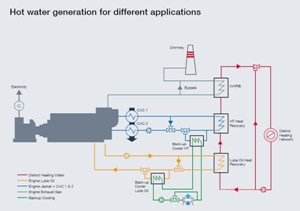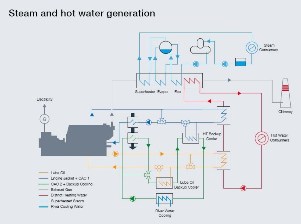|
When electricity is generated in gas or diesel engine-based power plants, waste heat at different temperature levels is produced. We offers different technologies to convert this waste heat into a useful energy form.
Cogeneration, also known as combined heat and power (CHP), refers to a group of proven technologies that operate together for the concurrent generation of electricity and useful heat in a process that is generally much more energy-efficient than the separate generation of electricity and useful heat. Combined Cooling, Heat and Power (CCHP) refers to the concurrent generation of electricity, heat and cooling. Both technologies CHP and CCHP are well-established, high-efficient, cost-effective and environmentally-friendly solutions. Widely used in distributed energy resources projects making an important contribution to the global energy demand.


When the generator set is running, waste heat and exhaust gas with different temperatures will be generated. The exhaust gas temperature of high-speed internal combustion engine is about 520 ℃, that of medium speed internal combustion engine is about 354 ℃, and that of gas turbine is about 550 ℃, with heat loss of about 36%. The temperature of generator cooling water reaches 100 ℃, and the heat loss is about 28%. In order to make full use of heat energy and turn waste into treasure, according to the working principle, structure, performance and characteristics of the generator, we have provided different technologies to convert the waste heat into an available energy form.
Our engine - based CHP and CCHP plants are designed to meet the overall thermal demand of the end consumer and can be used for a wide range of thermal applications - whether at industrial, city-wide or at individual building levels. The heat extracted from the engine’s exhaust gases can be utilised for steam generation required in the textiles, food, paper and chemicals industries. By including an exhaust gas or hot water driven absorption chiller, chilled water can be produced to run central air conditioning systems in hospitals, hotels and office blocks. The heat extracted from the engine lube oil, the engine jacket water and the charge air cooling circuits can be utilised for hot water generation, e.g. used in a district heating network for heating purposes.
The mission of the Combined Heat and Power (CHP) Partnership is to increase the use of cost-effective, environmentally beneficial CHP projects worldwide. To accomplish this mission, the Partnership has developed resources to assist energy users to design, install, and operate CHP systems at their facilities.
 |  |
| Hot water generation different applications | Steam and hot water generation |
Distributed Energy Resources, refers to the energy comprehensive utilization system distributed in the user side. Distributed energy generally adopt small scale, small volume, modular and distributed way, installed near the users, can output power, heat and cold sources independently. Using gas as fuel and cogeneration or trigeneration system is the main form of distributed energy.
The development process of energy industry in the Western Developed Countries, has experienced the evolution process of distributed-concentration-distributed. In the case of the energy industry development at present, the centralized energy got fully development. But in the long run, for the sake of increasing the security and reliability of urban power network, constructing a reasonable combination of centralized and distributed energy system, will lay a solid foundation for the energy industry development. Now, the Chinese government is developing the distributed energy projects actively, will bring infinite development space for distributed energy system.
Combined with waste heat boiler and lithium bromide units, gas turbine generator can compose cooling heating and power generation system, and can compose combined cycle with waste heat boiler. The above system not only can improve the comprehensive utilization efficiency of energy, but also effectively reduce the pollution of the environment, will has a broad prospect in the field of distributed power.
CHP Benefits:
1. Lower energy costs through more efficient utilisation of primary energy.
2. Improved environmental quality through reduced emissions of pollutants.
3. Recovered waste heat for a wide range of sustainable thermal applications.
4. Operational flexibility acc. to changes for heat and electricity demand.
 Mobile QR code
Mobile QR code






